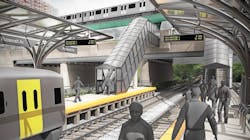MTA publishes Interborough Express feasibility study
The Metropolitan Transportation Authority (MTA) and New York Gov. Kathy Hochul took a small but important step to progress the Interborough Express (IBX) project forward with the release of a year-long feasibility study.
The proposed project, included in Gov. Hochul’s 2022 State of the State address, would utilize an existing rail right-of-way to provide a passenger rail connection for residents in Brooklyn and Queens.
The study found it is feasible to use the existing corridor for shared use and demand exists with daily ridership projections of between 74,000 and 85,000 passengers.
The rail corridor currently hosts freight traffic and has not had passenger rail traffic on it since 1924. The IBX proposal would involve 14 miles of the Bay Ridge Branch and the Fremont Secondary to provide the needed transit connection while controlling costs associated with new transit infrastructure. The project has “the potential to be transformative, tangibly improving the daily lives of tens of thousands of New Yorkers” by providing connections to up to 17 subway lines and the Long Island Rail Road, as well as reducing travel times within and between the two boroughs.
“Infrastructure is all about connection, and with the Interborough Express, we can connect people to their family and friends while also improving their quality of life,” Gov. Hochul said. “The Interborough Express will connect Brooklyn and Queens, not only shaving time off commutes but also making it easier to connect to subway lines across the route. With the completion of the feasibility study, we can move forward to the next phase of this project and bring us one step closer to making the Interborough Express a reality for New Yorkers.”
The feasibility study examined six initial modes of transport and narrowed those down to three alternatives that will be studied further, including conventional rail, light rail and bus rapid transit. The conventional rail alternative would see two dedicated passenger rail tracks running largely alongside the existing freight rail line, would use electrical multiple units and trains would be configured similarly to subway cars.
The light-rail alternative could be the costliest due to the need to separate the passenger traffic from freight per Federal Railroad Administration regulations. The light-rail alternative would see some parts of the corridor run above the freight tracks on a viaduct, as well as on existing streets, while most of the line would run side-by-side the freight tracks. The bus rapid transit alternative calls for electric buses operating on the same corridor as a light-rail alternative.
The need in the community
The IBX project would serve “some of New York City’s most diverse neighborhoods.” Of the population within half of a mile of the corridor, seven in 10 are people of color, one quarter of the residents have limited English fluency, half are zero-car households and three in 10 households have income below 150 percent of the poverty line.
The feasibility study determined the IBX project had potential to access areas currently served by existing subway routes, as well as the potential to connect areas in Brooklyn and Queens that lack direct rapid transit connections.
The area is expected to grow from 900,000 residents to 941,000 by 2041. Additionally, the outer boroughs accounted for 48 percent of the city’s total job growth and the study determined improved transit infrastructure would help these neighborhoods better absorb and accommodate new residents and jobs.
“MTA riders deserve a reliable and wide-reaching transit system that promotes equity, and this study proves the Interborough Express will provide better access to jobs, education and economic opportunities for some 80,000 New Yorkers in Queens and Brooklyn. I want to thank Gov. Hochul for her leadership on this exciting project and look forward to working with local communities to get work underway,” said MTA Chair and CEO Janno Lieber.
Next steps
The feasibility study outlines next steps for the project and notes “while the project is still costly and complex, even implementing smaller portions of the corridor can generate major benefits.”
MTA will conduct a 20-year Needs Assessment that will evaluate costs, benefits and potential issues. The assessment is also a step toward potentially including the IBX project in future MTA capital programs.
A preferred alternative would be selected following the determination of station locations and potential affected properties. Once an alternative is selected, environmental reviews can start with community engagement at every stage of the process, which will then culminate in design and construction.
About the Author

Mischa Wanek-Libman
Group Editorial Director
Mischa Wanek-Libman is director of communications with Transdev North America. She has more than 20 years of experience working in the transportation industry covering construction projects, engineering challenges, transit and rail operations and best practices.
Wanek-Libman has held top editorial positions at freight rail and public transportation business-to-business publications including as editor-in-chief and editorial director of Mass Transit from 2018-2024. She has been recognized for editorial excellence through her individual work, as well as for collaborative content.
She is an active member of the American Public Transportation Association's Marketing and Communications Committee and served 14 years as a Board Observer on the National Railroad Construction and Maintenance Association (NRC) Board of Directors.
She is a graduate of Drake University in Des Moines, Iowa, where she earned a Bachelor of Arts degree in Journalism and Mass Communication.
